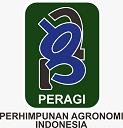Population Growth of Tribolium confusum (Coleoptera: Tenebrionidae) on Various Commercial and Non-commercial Flour
Abstract
Tribolium confusum Jacquelin du Val (Coleoptera: Tenebrionidae) is a major stored product pest that can damage flour in storage. The infestation of T. confusum causes contamination of stored grain, such as flour. Research about the population growth of T. confusum in various commercial and non-commercial flours is still limited. This study aims to determine the population growth of T. confusum in various commercial and non-commercial flours. The study was conducted using the no-choice test method (NCTM). This study used a treatment jar containing 30 g of diet and infested 15 pairs of T. confusum adults for 7 days. Data obtained from this research were analyzed using analysis of variance (ANOVA) and further analyzed using the Duncan Multiple Range Test (DMRT) at a 5% significance level. The results showed that the number of larvae, pupae, and F1 progeny of T. confusum was higher in non-commercial red rice flour (80, 50 individuals; 59, 50 individuals; 57, 50 individuals) compared to other types of flour. The chemical characteristics of diets that can affect the population growth of T. confusum include fat, ash, carbohydrate, and phenol content. In conclusion, understanding the chemical characteristics of flour is crucial for developing a strategy to control T. confusum.
Keywords
Full Text:
PDFReferences
Afgani, C. A., Nairfana, I., Sari, R. N., & Komarudin, N. A. (2023). Pelatihan Pembuatan Tepung Beras di Desa Parate Kecamatan Samapuin Kabupaten Sumbawa. Jurnal Agro Dedikasi Masyarakat (JADM), 4(1), 23–28. https://doi.org/https://doi.org/10.31764/jadm.v4i1.15227
Ajayi, E. O., Oladipupo, S. O., & Ajisafe, O. (2019). Influence of Processing and Substrate Variety on Survival and Development of Tribolium confusum (Coleoptera: Tenebrionidae). Archives of Phytopathology and Plant Protection, 52(3–4), 356–370. https://doi.org/10.1080/03235408.2019.1621018
Aliyah, S., & Setiawati, S. I. (2018). Perbandingan Formula Enteral Rendah Lemak Berbasis Tepung Edamame dengan Formula Komersial Rendah Lemak. Media Gizi Indonesia, 13(1), 1. https://doi.org/10.20473/mgi.v13i1.1-11
Arifin, B. N., Suhartatik, N., & Mustofa, A. (2023). Antioxidant Activity of Colored Rice Flour with Drying Temperature Variations. Jurnal Teknologi Dan Industri Pangan Unsri, 8(2), 195–202. https://doi.org/https://doi.org/10.33061/jitipari.v8i2.7250
Astuti, L. P., Lestari, Y. E., Rachmawati, R., & Mutala’liah. (2020). Preference and Development of Tribolium castaneum (Herbst, 1797) (Coleoptera: Tenebrionidae) in Whole Grain and Flour Form of Five Corn Varieties. Biodiversitas, 21(2), 564–569. https://doi.org/10.13057/biodiv/d210218
Astuti, L. P., Mudjiono, G., Rasminah Ch., S., & Rahardjo, B. T. (2013). Susceptibility of Milled Rice Varieties to the Lesser Grain Borer (Rhyzopertha dominica, F). Journal of Agricultural Science, 5(2), 145–149. https://doi.org/10.5539/jas.v5n2p145
Astuti, L. P., Rizali, A., Firnanda, R., & Widjayanti, T. (2020). Physical and Chemical Properties of Flour Products Affect the Development of Tribolium castaneum. Journal of Stored Products Research, 86, 1. https://doi.org/10.1016/j.jspr.2019.101555
Chirigos, M. A., Meiss, A. N., Pisano, J. J., & Taylor, M. W. (1960). Growth Response of the Confused Flour Beetle, Tribolium confusum (Duval) to Six Selected Protein Sources. The Journal of Nutrition, 72(2), 121–130. https://doi.org/https://doi.org/10.1093/jn/72.2.121
Cholilie, I. A., & Zuari, L. (2021). Pengaruh Variasi Jenis Perekat terhadap Kualitas Biobriket Berbahan Serabut dan Tandan Buah Lontar (Borassus flabellifer L.). Agro Bali: Agricultural Journal, 4(3), 391–402. https://doi.org/10.37637/ab.v4i3.774
Cohen, A. C. (2015). Insect diets: Science and Technology. New York: CRC Press.
de Mendiburu, F. (2021). Agricolae: Statistical Procedures for Agricultural Research. R package version 1.3-5. Retrieved from https://CRAN.Rproject.org/package=agricolae
Đukić, N., Radonjić, A., Popović, B., Kljajić, P., Pražič-Golić, M., & Andrić, G. (2022). The Impact of the Protein-Carbohydrate Ratio in Animal Feed and the Initial Insect Population Density on the Development of The Red Flour Beetle, Tribolium castaneum. Journal of Stored Products Research, 97, 1–7. https://doi.org/10.1016/j.jspr.2022.101983
Ekafitri, R., & Isworo, R. (2014). Pemanfaatan Kacang-Kacangan sebagai Bahan Baku Sumber Protein untuk Pangan Darurat. Pangan, 23(2), 134–144. https://doi.org/https://doi.org/10.33964/jp.v23i2.57
Fardisi, M., Mason, L. J., & Ileleji, K. E. (2013). Development and Fecundity Rate of Tribolium castaneum (Herbst) on Distillers Dried Grains with Solubles. Journal of Stored Products Research, 52, 74–77. https://doi.org/10.1016/j.jspr.2012.12.001
Fardisi, M., Mason, L. J., Ileleji, K. E., & Richmond, D. S. (2019). Effect of Chemical and Physical Properties of Dried Distillers Grains with Solubles (DDGS) on Tribolium castaneum (Herbst) Development. Journal of Stored Products Research, 80, 57–64. https://doi.org/10.1016/j.jspr.2018.11.008
Farrar, R. R., Barbour, J. D., & Kennedy, G. G. (1989). Quantifying Food Consumption and Growth in Insects. Annals of the Entomological Society of America, 82(5), 593–598. https://doi.org/https://doi.org/10.1093/aesa/82.5.593
Gerken, A. R., & Campbell, J. F. (2020). Oviposition and Development of Tribolium castaneum Herbst (Coleoptera: Tenebrionidae) on Different Types of Flour. Agronomy, 10(10), 1–18. https://doi.org/10.3390/agronomy10101593
Ghada, B. K., Marwa, R., Shah, T. A., Dabiellil, M., Dawoud, T. M., Bourhia, M., Tebra, T., Hadhami, C., Tarek, S., & Chiraz, C. H. (2025). Phytochemical Composition, Antioxidant Potential, and Insecticidal Activity of Moringa oleifera Extracts against Tribolium castaneum: A Sustainable Approach to Pest Management. BMC Plant Biology, 25(579), 1–21. https://doi.org/10.21203/rs.3.rs-6010436/v1
Hagstrum, D. W., & Subramanyam, B. (2009). Stored-Product Insect Resource. St. Paul: AACC International Press.
Heinrichs, E. A., Medrano, E. G., & Rapusas, H. R. (1985). Genetic Evaluation for Insect Resistance in Rice. Los Banos: International Rice Research Institute.
Hendrival, Maulida, A., Julianti, & Khaidir. (2022). Klasifikasi Kerentanan Tepung Beras dan Jagung terhadap Hama Kumbang Tepung Merah (Tribolium castaneum Herbst). Jurnal Agrotek Indonesia, 1(7), 19–25. https://doi.org/10.33661/jai.v7i1.5646
Jung, J. M., Byeon, D. H., Kim, S. H., Jung, S. H, & Lee, W. H. (2020). Estimating Economic Damage to Cocoa Bean Production with Changes in the Spatial Distribution of Tribolium castaneum (Herbst) (Coleoptera: Tenebrionidae) in Response to Climate Change. Journal of Stored Products Research, 89. https://doi.org/10.1016/j.jspr.2020.101681
Kavallieratos, N. G., Andrić, G., Golić, M. P., Nika, E. P., Skourti, A., Kljajić, P., & Papanikolaou, N. E. (2020). Biological Features and Population Growth of Two Southeastern European Tribolium confusum Jacquelin du Val (Coleoptera: Tenebrionidae) Strains. Insects, 11(4), 1–11. https://doi.org/10.3390/insects11040218
Kayode, O. Y., Adedire, C. O., & Akinkurolere, R. O. (2014). Influence of Four Cereal Flour on the Growth of Tribolium castaneum Herbst (Coleoptera: Tenebrionidae). Ife Journal of Science, 16(3), 505–516. https://www.ajol.info/index.php/ijs/article/view/131708
Kikuta, S. (2020). The Cytotoxic Effect of Genistein, a Soybean Isoflavone, against Cultured Tribolium Cells. Insects, 11(4). https://doi.org/10.3390/insects11040241
Kogan, M. (1989). Bioassays for Measuring Quality of Insect Food. In J. R. Miller & T. A. Miller (Eds.), Insect-Plant Interactions. New York: Springer Science and Business Media.
Lazzari, S. M. N., & Lazzari, F. A. (2012). Insect Pests in Stored Grain. In A. R. Panizzi & J. R. P. Parra (Eds.), Insect Bioecology and Nutrition for Integrated Pest Management. New York: CRC Press.
Locatelli, D. P., Limonta, L., & Stampini, M. (2008). Effect of Particle Size of Soft Wheat Flour on the Development of Ephestia kuehniella Zeller (Lepidoptera: Pyralidae). Journal of Stored Products Research, 44(3), 269–272. https://doi.org/10.1016/j.jspr.2008.02.004
Mahroof, R. M., & Hagstrum, D. W. (2012). Biology, Behavior, and Ecology of Insects in Processed Commodities. In D. W. Hagstrum, T. W. Phillips, & G. Cuperus (Eds.), Stored Product Protection. Manhattan: Kansas State Research and Extension.
Martiyanti, M. A. A., Fransiska, & Natalia, E. (2022). Pengaruh Substitusi Tepung Ketan terhadap Karakteristik Sensori dan Tingkat Kesukaan Makanan Tradisional Kue Dange. Agrofood: Jurnal Pertanian Dan Pangan, 4(2), 24–30.
https://jurnal.polteq.ac.id/index.php/agrofood/article/view/118/99
Mickel, C. E., & Standish, J. (1946). Susceptibility of Edible Soya Products in Storage to Attack by Tribolium confusum Duv. In Minnesota Technical Bulletin. Minneapolis: St. Paul: University of Minnesota, Agricultural Experiment Station.
Ministry of Agriculture. (2023). Statistik Konsumsi Pangan Tahun 2023. Jakarta: Pusat Data dan Informasi Pertanian.
Namin, F. R., Naseri, B., Ganbalani, G. N., & Razmjou, J. (2018). Demographic Studies of Tribolium castaneum (Coleoptera: Tenebrionidae) on Various Barley Cultivars. Journal of Stored Products Research, 79, 60–65. https://doi.org/10.1016/j.jspr.2018.09.002
Nasution, E., Sudaryati, E., & Asfriyati. (2017). Pemanfaatan Beras Merah dan Jagung dalam Pembuatan Mie sebagai Bahan Pangan Fungsional. Abdimas Talenta, 2(2), 200–205. https://doi.org/10.32734/anr.v1i2.233
Nowaczyk, K., Obrepalska-Steplowska, A., Gawlak, M., Throne, J. E., Olejarski, P., & Nawrot, A. J. (2009). Molecular Techniques for Detection of Tribolium confusum Infestations in Stored Products. Journal of Economic Entomology, 102(4), 1691–1695. https://doi.org/http://dx.doi.org/10.1603/029.102.0437
Pai, A. (2010). Tribolium. In M. D. Breed & J. Moore (Eds.), Encyclopedia of Animal Behavior. Atlanta: Academic Press.
Parra, J. R. P. (2012). The Evolution of Artificial Diets and Their Interactions in Science and Technology. In A. R. Panizzi & J. R. P. Parra (Eds.), Insect Bioecology and Nutrition for Integrated Pest Management. New York: CRC Press.
Parra, J. R. P., Panizzi, A. R., & Haddad, M. L. (2012). Nutritional Indices for Measuring Insect Food Intake and Utilization. In A. R. Panizzi & J. R. P. Parra (Eds.), Insect bioecology and Nutrition for Integrated Pest Management. New York: CRC Press.
Pasha, S. S., & Abd-Eltawab, S. A. (2022). The Effect of Different Flours on Tribolium confusum and the Effect of Infestation on Various Food Parameters. International Journal of Agriculture and Plant Science, 4(1), 74–80. www.agriculturejournal.in
R Core Team. (2023). R: A language and Environment for Statistical Computing. R Foundation for Statistical Computing, Vienna Austria. Retrieved from https://www.R-project.org/.
Rees, D. (2004). Insects of Stored Products. Australia: CSIRO Publishing.
Romadoni, F. P., & Hendrival. (2018). Kajian Kerentanan dan Kerusakan Beras Lokal Provinsi Sumatera Selatan terhadap Hama Pascapanen Sitophilus oryzae L. (Coleoptera: Curculionidae). Jurnal Biota, 4(2), 90–97. https://doi.org/https://doi.org/10.19109/Biota.v4i2.2104
Shah, J. A., Vendl, T., Aulicky, R., & Stejskal, V. (2021). Frass Produced by the Primary Pest Rhyzopertha dominica Supports the Population Growth of the Secondary Stored Product Pests Oryzaephilus surinamensis, Tribolium castaneum, and T. confusum. Bulletin of Entomological Research, 111(2), 153–159. https://doi.org/10.1017/S0007485320000425
Shaurub, E. S. H., Gharsa, G. M. A., & Sabbour, M. M. (2022). Sustainability of Development, Survivability, and Biomass Are a Function of Temperature and Diet: Implications in Tribolium confusum (Coleoptera: Tenebrionidae) With Benefits for Its Management Strategy. Invertebrate Reproduction and Development, 66(1), 50–58. https://doi.org/10.1080/07924259.2021.2025160
Wong, N., & Lee, C. Y. (2011). Relationship Between Population Growth of the Red Flour Beetle Tribolium castaneum and Protein and Carbohydrate Content in Flour and Starch. Journal of Economic Entomology, 104(6), 2087–2094. https://doi.org/10.1603/EC11234
Refbacks
- There are currently no refbacks.


























